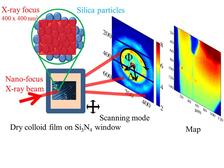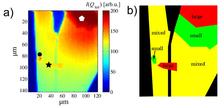Schematic setup of the XCCM experiment. (Credit: authors)
A new technique, nano-beam X-ray cross-correlation microscopy (XCCM), which allows studying the local orientational order in matter with high spatial resolution, was introduced by Martin A. Schroer and his coauthors from DESY. Using a nanofocus X-ray beam of 400 x 400 nm2, XCCM permits to study also systems showing only short-range order, such as glassy samples. With this method, published in the journal Soft Matter, limitations of conventional scanning electron microscopy or standard scattering techniques can be overcome.
The XCCM experiments were conducted at beamline P10 using the high brilliance and coherence of DESY’s light source PETRA III. Employing the Göttingen Instrument for Nano-Imaging with X-rays (GINIX) setup, colloidal films were scanned with a nanofocus X-ray beam. Due to the small focal size, only a limited number of colloidal particles gave rise to the recorded two-dimensional small angle X-ray scattering (SAXS) patterns. This allows to determine the orientational order also for samples having only short-range order which is not possible with larger X-ray beams. The local type and strength of the orientational order are determined by analyzing these SAXS patterns with the recently developed X-ray cross-correlations analysis (XCCA).
The researcher team from the Coherent X-ray Scattering (CXS) group led by Gerhard Grübel demonstrated the potential of this technique by studying densely-packed thin colloidal films made out of dried binary mixtures of spherical silica particles. Such films, consisting of colloidal particles, can exhibit exciting new properties such as photonic band gaps or negative refraction and can be used as photonic crystals or as templates for the formation of nanostructured materials such as catalysts. Here, special attention has to be paid to the local order within these films since detailed knowledge of such local order is both mandatory for the fabrication of materials with dedicated functional properties as well as for our understanding of self-assembly processes.
With XCCM spatially resolved maps of binary silica particle films are obtained. In the study a particle mixtures consisting of small (radius R = 11.2 nm, 8.9 % polydispersity) and large (radius R = 19.3 nm, 13.5 % polydispersity) spherical particles was used. Whereas the lower polydispersity of the small particles is expected to favor crystal formation, the higher polydispersity of the large silica particles suppresses formation of crystals and leads to the formation of amorphous glassy structures. The spatial maps obtained from XCCM show a heterogeneous distribution of the particles within the dense films as well as of the orientational order between them. Three different types of domains were identified: regions containing mainly the large particles, regions containing mainly the small particles, and regions where both particle species are mixed. This heterogeneous particle distribution is a result of the drying and the associated self-assembly process of the colloidal particles. The different regions within the films have different orientational order. Whereas the mixed regions (large and small particles) have dominant two-fold order, weaker four-fold and marginal six-fold order, regions made out of large particles are characterized by a reduced orientational order. Regions of small particles are highly ordered showing actually crystalline order. It seems that the different particle polydispersities directly affects the orientational order within the particle film as determined by XCCM.
Moreover, the scientists from DESY’s Coherent X-ray Scattering Group showed that preferential orientations of the particle domains can be studied by the cross-correlation analysis yielding information on particle film formation. For their samples they found patches with an average size 8 - 10 µm. Thus, by XCCM the structure and orientational order of films made out of nanometer sized colloids can be determined.
Possible future applications are studies of nanoparticle film formation under different drying conditions or crystallization and vitrification processes.
Original publication:
Martin A. Schroer, Christian Gutt, Felix Lehmkühler, Birgit Fischer, Ingo Steinke, Fabian Westermeier, Michael Sprung and Gerhard Grübel, "Nano-beam X-ray microscopy of dried colloidal films", Soft Matter, 2015,11, 5465-5472, DOI: 10.1039/C5SM00609K








